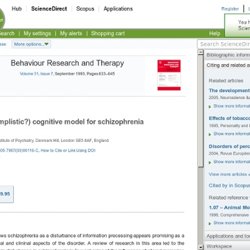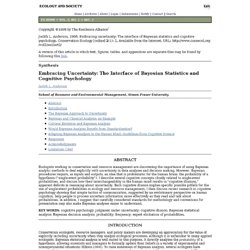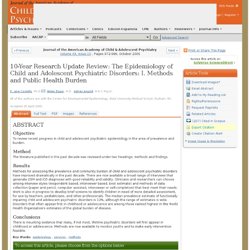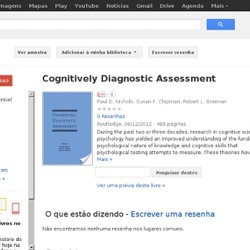

Cog-DSM. Behaviour Research and Therapy - A simple (or simplistic?) cognitive model for schizophrenia. Invited essay David R.

Hemsley Psychology Department, Institute of Psychiatry, Denmark Hill, London SE5 8AF, England Received 30 March 1993 Available online 29 May 2002 , How to Cite or Link Using DOI. PsycNET - DOI Landing page. Impact of Neurocognition on Social and Role Functioning in Individuals at Clinical High Risk for Psychosis. Bridging the Gap between Schizophrenia and Psychotic Mood Disorders: Relating Neurocognitive Deficits to Psychopathology.
Genetic overlap of schizophrenia and bipolar disorder in a high-density linkage survey in the Portuguese Island population. American journal of medical genetics.

Part B, Neuropsychiatric genetics : the official publication of the International Society of Psychiatric Genetics ( 2012 ) Abstract Recent family and genome-wide association studies strongly suggest shared genetic risk factors for schizophrenia (SZ) and bipolar disorder (BP). However, linkage studies have not been used to test for statistically significant genome-wide overlap between them. Forty-seven Portuguese families with sibpairs concordant for SZ, BP, or psychosis (PSY, which includes either SZ or psychotic BP) were genotyped for over 57,000 markers using the Affymetrix 50K Xba SNP array. A Video Ethnography Approach for Linking Naturalistic Behaviors to Research Constructs of Neurocognition in Schizophrenia.
Meta-Analysis in Medicine and Health Policy - Google Books. Bayesian Biostatistics - Donald A. Berry, Dalene Stangl - Google Books. Metafor [The metafor package] Conservation Ecology: Embracing uncertainty: The interface of Bayesian statistics and cognitive psychology. Copyright ©1998 by The Resilience Alliance * Judith L.

Anderson. 1998. Embracing uncertainty: The interface of Bayesian statistics and cognitive psychology. Conservation Ecology [online] 2 (1): 2. Available from the Internet. A version of this article in which text, figures, tables, and appendices are separate files may be found by following this link . Synthesis. Trait theory. In psychology , trait theory is an approach to the study of human personality .

Trait theorists are primarily interested in the measurement of traits , which can be defined as habitual patterns of behavior, thought, and emotion. [ 1 ] According to this perspective, traits are relatively stable over time, differ across individuals (e.g. some people are outgoing whereas others are shy), and influence behavior. Gordon Allport was an early pioneer in the study of traits, which he sometimes referred to as dispositions. In his approach, central traits are basic to an individual's personality, whereas secondary traits are more peripheral.
Common traits are those recognized within a culture and may vary between cultures. Cardinal traits are those by which an individual may be strongly recognized. There is a nearly unlimited number of potential traits that could be used to describe personality. . [ edit ] The Two taxonomies Both approaches extensively use self-report questionnaires. PsycNET - DOI Landing page. Psychological Medicine - Abstract - The omnipotence of voices: testing the validity of a cognitive model. Research Article The omnipotence of voices: testing the validity of a cognitive model MAX BIRCHWOOD a1 and PAUL CHADWICK a2 a1 Early Psychosis Service and Research and Development Unit (University of Birmingham), Archer Centre, All Saints Hospital, Birmingham a2 Royal South Hants Hospital, Southampton Abstract Background.

A preliminary report by the authors suggested that the range of affect generated by voices (anger, fear, elation) was linked not to the form, content or topography of voice activity, but to the beliefs patients held about them, in particular their supposed power and authority. Methods. Results. Conclusion. Myerson_etal_1990.pdf. Bayesian Dynamic Trust Model. Learning Factors Analysis – A General Method for Cognitive Model Evaluation and Improvement.
Journal of the American Academy of Child & Adolescent Psychiatry - 10-Year Research Update Review: The Epidemiology of Child and Adolescent Psychiatric Disorders: I. Methods and Public Health Burden. Accepted 25 April 2005.

Objective To review recent progress in child and adolescent psychiatric epidemiology in the area of prevalence and burden. Method The literature published in the past decade was reviewed under two headings: methods and findings. Results. Cognitively Diagnostic Assessment - Google Books. During the past two or three decades, research in cognitive science and psychology has yielded an improved understanding of the fundamental psychological nature of knowledge and cognitive skills that psychological testing attempts to measure.

These theories have reached sufficient maturity, making it reasonable to look upon them to provide a sound theoretical foundation for assessment, particulary for the content of assessments. This fact, combined with much discontentedness over current testing practices, has inspired efforts to bring testing and cognitive theory together to create a new theoretical framework for psychological testing -- a framework developed for diagnosing learners' differences rather than for ranking learners based on their differences. This volume presents some initial accomplishments in the effort to bring testing and cognitive theory together.